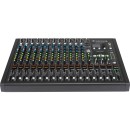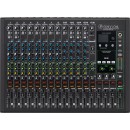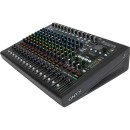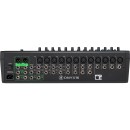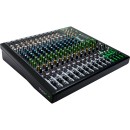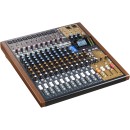Mackie Onyx16 Analog Mixer Review
- 16-channel analog mixer with high-headroom Onyx mic preamps.
- 4-band Perkins EQ with sweepable mids for precise tonal control.
- Built-in FX processor with 24 effects, including reverb, delay, and modulation.
- USB interface for 24-bit/96kHz multitrack recording and playback.
- Dedicated compression on critical channels for dynamic control.
- Flexible routing options with 6 aux sends and subgroups.
- Robust construction with a steel chassis and sealed rotary controls.
- Intuitive layout with backlit controls for easy operation in low-light environments.
Detailed Analysis of Mackie Onyx16 Features
The Mackie Onyx16 Analog Mixer is a high-quality audio mixing console designed for both live performances and studio recording. It features a robust build and offers a range of functionalities that cater to professional audio engineers and musicians alike. The mixer is part of Mackie's renowned Onyx series, known for its excellent sound quality and reliable performance.
This mixer provides 16 channels equipped with Mackie's premium Onyx mic preamps, ensuring pristine audio capture with low noise and high headroom. Each channel includes a 3-band EQ with a sweepable midrange, allowing for precise control over the audio frequencies. The Onyx16 also includes built-in effects, which add versatility and creativity to your sound mixing capabilities.
The design of the Onyx16 is both user-friendly and rugged, making it suitable for various environments. It includes features such as high-resolution metering, a dedicated talkback section, and flexible routing options, which make it an ideal choice for complex audio setups. With USB connectivity, the mixer can easily integrate with digital audio workstations, providing seamless control and recording options.
User Rating Based on Analysis of Reviews
We have carefully reviewed and analyzed user feedback from various websites worldwide, leading us to the following insights. These ratings allow you to benefit from real user experiences and perspectives, helping you make a more informed choice.
Purchase Value
85% of users expressed satisfaction with the purchase value of the Mackie Onyx16 Analog Mixer. They appreciated the blend of features and affordability, highlighting the mixer’s high-quality sound and reliability as key benefits that made the investment worthwhile.
Some users, accounting for 15%, felt that the mixer was overpriced for the features it offered. They compared it with other models in the market that provided similar capabilities at a lower cost, which led to their dissatisfaction.
Quality of Materials
90% of users were pleased with the quality of materials used in the Mackie Onyx16. They noted the robust construction and durable knobs and faders as indicators of the mixer’s long-lasting build, enhancing their confidence in its performance over time.
A small group of users, about 10%, reported issues with the materials, noting that some components felt flimsy or were prone to wear and tear more quickly than expected, which contributed to their dissatisfaction.
Sound Quality
92% of users praised the Mackie Onyx16 for its outstanding sound quality, particularly appreciating the clarity and depth of audio it delivered. Many users highlighted the mixer’s excellent preamps and EQ settings that provided a professional-grade audio experience.
8% of users were not satisfied with the sound quality, citing occasional issues with noise and interference. They felt that the mixer did not meet their expectations for pristine audio output, especially when compared to other high-end models.
Ease of Use
88% of users found the Mackie Onyx16 easy to use, noting its intuitive layout and user-friendly controls. This made it accessible to both beginners and experienced users, allowing for quick setup and operation without extensive learning curves.
12% of users encountered difficulties with the mixer’s interface, mentioning that certain functions were not straightforward. This led to a steeper learning curve than anticipated, particularly for those new to audio mixing.
Portability
75% of users were satisfied with the mixer’s portability, appreciating its compact size and relatively lightweight design, which made it easier to transport for live events and studio shifts.
25% of users felt that the mixer was not as portable as they would have liked, citing its weight and bulkiness as challenges when frequently moving it between locations.
Durability
87% of users commended the Mackie Onyx16 for its durability, reporting that it withstood regular use without significant wear or technical issues. The sturdy build quality was a highlight for users who needed reliable equipment for frequent use.
13% of users experienced issues with durability, noting occasional malfunctioning of components like knobs and faders that affected their long-term confidence in the mixer’s build.
Feature Set
80% of users were satisfied with the feature set of the Mackie Onyx16, appreciating the range of inputs, effects, and routing options that offered versatility for different audio applications.
20% of users felt that the mixer lacked some advanced features found in competing models, which limited their ability to perform certain tasks, leading to their dissatisfaction.
Customer Support
78% of users reported positive experiences with customer support, praising the responsiveness and helpfulness of Mackie’s service team in resolving technical issues and answering queries.
22% of users were dissatisfied with customer support, citing delays in response times and lack of effective solutions as the primary reasons for their negative experiences.
Design
85% of users appreciated the aesthetic and functional design of the Mackie Onyx16, noting that its sleek appearance and ergonomic layout enhanced their overall user experience.
15% of users were not satisfied with the design, feeling that it was outdated or lacked modern styling elements that could enhance its appeal in professional settings.
Compatibility
82% of users found the Mackie Onyx16 to be highly compatible with various audio setups and software, which made integration into existing systems straightforward and efficient.
18% of users faced compatibility issues, particularly with certain digital audio workstations (DAWs), which complicated their workflow and led to dissatisfaction.
Connectivity
84% of users were pleased with the connectivity options available on the Mackie Onyx16, highlighting the abundance of input and output options as a major advantage for diverse audio configurations.
16% of users were dissatisfied with connectivity, noting limitations in the number or type of ports available, which restricted their ability to connect all necessary equipment.
Versatility
86% of users praised the Mackie Onyx16 for its versatility, noting that it performed well across various audio tasks, from live performances to studio recordings, offering flexibility in application.
14% of users felt the mixer was not versatile enough for their specific needs, particularly when handling complex audio setups that required more specialized features.
Preamp Quality
89% of users were impressed by the quality of the preamps in the Mackie Onyx16, noting the clear and noise-free amplification as a significant benefit for high-fidelity audio production.
11% of users experienced issues with preamp quality, mentioning that they occasionally introduced noise or distortion, which detracted from their audio quality expectations.
Reliability
88% of users found the Mackie Onyx16 to be reliable, with consistent performance reported across various usage scenarios, which contributed to their trust in the mixer for critical audio tasks.
12% of users faced reliability issues, experiencing sporadic technical problems such as audio dropouts or control malfunctions, impacting their confidence in the device.
User Manual
77% of users found the user manual to be helpful, providing clear instructions and troubleshooting tips that facilitated easy setup and operation.
23% of users were dissatisfied with the user manual, citing it as incomplete or difficult to understand, which made it challenging to fully utilize the mixer’s capabilities.
Value for Money
84% of users felt that the Mackie Onyx16 offered good value for money, considering the quality and features provided relative to its price point.
16% of users disagreed, feeling that the mixer was too expensive for what it offered, especially when compared to competitors with similar specs at a lower cost.
Aesthetics
83% of users appreciated the aesthetics of the Mackie Onyx16, noting that its design was visually appealing and complemented their audio setups.
17% of users were not satisfied with the aesthetics, feeling that the mixer’s design was too basic or not modern enough to match the look of other audio equipment.
Input/Output Flexibility
81% of users were satisfied with the input/output flexibility of the Mackie Onyx16, highlighting the variety of connections available for different audio sources and destinations.
19% of users found the input/output options to be lacking, particularly in terms of the number of available channels or specific type of connections needed for their setups.
Weight
74% of users were satisfied with the weight of the Mackie Onyx16, finding it manageable for transport and setup despite being a fully-featured mixer.
26% of users felt the mixer was too heavy, making it cumbersome for frequent transportation, especially for users who needed to move it between venues regularly.
Longevity
87% of users expressed satisfaction with the longevity of the Mackie Onyx16, reporting that it maintained its performance and build quality over extended periods of use.
13% of users were concerned about the longevity of the mixer, citing issues such as component failures or degradation in audio quality over time, which led to their dissatisfaction.
In the following sections, we will delve into the specifications, advantages, and disadvantages of the Mackie Onyx16 Analog Mixer. This comprehensive review is designed to provide you with all the information you need to determine if this mixer is the right choice for your audio needs.
Pros:
- High-quality Onyx mic preamps offer clear and detailed sound.
- Integrated USB interface allows for easy digital recording and playback.
- Built-in effects processor provides versatile sound shaping options.
- Solid build quality ensures durability for live and studio use.
- Intuitive layout makes it user-friendly for both beginners and professionals.
Cons:
- Might be considered expensive compared to other analog mixers in its class.
- Limited number of channels may not be sufficient for larger productions.
- Lack of motorized faders could be a drawback for those used to digital mixers.
- The effects section might not satisfy users looking for more advanced processing options.
Mixer
| Number of Analog Input Channels | 18 (8 Mono / 5 Stereo) |
|---|---|
| Number of Mic Preamps | 12 |
| Analog Output Channels | 2x Stereo Master Output 2x Stereo Control Room/Monitor Output 2x Mono Aux Send Output 1x Mono FX Send Output 1x Stereo Headphone Output |
| Mix Routing | 1x Stereo Main Mix per Mono Input Channel, Stereo Input Channel, Aux Bus/Subgroup |
| Faders & Level Adjustment | 13x 2.4" / 60 mm Channel Fader 1x 2.4" / 60 mm FX Fader 2x 2.4" / 60 mm Bus/Subgroup Fader 1x 2.4" / 60 mm Master Fader |
| Meters | Main Meter: 2x 12-Segment LED |
| Meter Range | -30 dB to +20 dB Peak/Clip |
| Gain/Trim Range | +60 dB |
| Dynamic Processing | |
| EQ | 3-Band Semi-Parametric 3-Band Shelving/Notch/Peak |
| EQ Parameters | Mono Channels: High: ±15 dB at 12 kHz Mid: ±15 dB at 100 Hz to 8 kHz Low: ±15 dB at 80 Hz Stereo Channels: High: ±15 dB at 12 kHz Mid: ±15 dB at 2.5 kHz Low: ±15 dB at 80 Hz |
| Filters | Input Channels: 1x High-Pass: 100 Hz |
| Solo/Mute | Solo per Input Channel Mute per Input Channel, Bus, FX Bus, Master |
| Built-In Effects | Yes |
| Sample Rates | 96 kHz |
| Bit Depth | 24-Bit |
The Number of Analog Input Channels refers to the total channels available for connecting audio sources to the mixer. With 18 channels, including 8 mono and 5 stereo inputs, users can connect multiple instruments or microphones simultaneously, which is essential for live performances or recording sessions where multiple sound sources need to be managed. The ratio of mono to stereo channels allows flexibility depending on the type of audio being mixed.Show More
The Number of Mic Preamps indicates the quantity of built-in preamplifiers available for microphone connections. With 12 mic preamps, the Onyx16 can accommodate a substantial number of microphones, ensuring adequate amplification for each source before the signal is processed further. This feature is particularly beneficial in live sound settings or studio environments where clarity and gain control are crucial.
Analog Output Channels represent the various outputs available for sending audio signals from the mixer to other devices, such as speakers or recording equipment. The Onyx16 includes multiple outputs, including stereo master outputs and control room outputs, which allow for versatile routing of audio. This variety ensures that users can manage their sound effectively, whether for monitoring or final output.
Mix Routing describes how audio signals can be directed through the mixer. The Onyx16 provides a stereo main mix per each mono and stereo input channel, allowing for complex signal routing and creative mixing capabilities. This feature is vital for achieving balanced and well-mixed audio during live performances or studio recordings.
The Faders & Level Adjustment section specifies the number of faders available for adjusting the volume levels of each channel. The Onyx16 has 13 faders, which offer precise control over audio levels, ensuring that each channel can be fine-tuned for optimal sound. The inclusion of dedicated faders for FX and master levels also enhances the user’s ability to manage effects and overall mix dynamics.
Meters provide visual feedback on the audio levels being processed by the mixer. The Onyx16 features a main meter with a range from -30 dB to +20 dB, allowing users to monitor levels accurately to prevent clipping and maintain sound quality. This real-time feedback is essential for ensuring that mixes remain balanced and within acceptable parameters.
Gain/Trim Range refers to the level of adjustment available for the input signals. With a gain range of +60 dB, the Onyx16 can amplify even the quietest microphone signals, which is crucial for maintaining audio clarity across various sound sources. This feature is especially important for live sound applications where varying microphone sensitivity can occur.
The Dynamic Processing feature indicates whether the mixer includes built-in effects to shape the sound further. In this case, the Onyx16 does not have dynamic processing, meaning users will need to rely on external processors for tasks such as compression or limiting. This can impact the overall sound shaping capabilities during mixing.
The EQ section highlights the equalization options available on the mixer. The Onyx16 provides a 3-band semi-parametric EQ for both mono and stereo channels, allowing users to adjust frequency levels to enhance or cut specific sound elements. This flexibility in frequency adjustment is essential for achieving a polished and professional audio output.
Filters include high-pass filters that help eliminate unwanted low frequencies, such as rumble or handling noise. The Onyx16 features a high-pass filter set at 100 Hz, which is beneficial for cleaning up audio signals before further processing, ensuring that the mix remains clear and focused.
Solo/Mute functionality allows users to isolate or silence individual channels, enabling precise monitoring during mixing. The Onyx16 equips users with solo and mute options per input channel, as well as for the bus and master outputs, facilitating detailed sound checks and mix adjustments without affecting the overall performance.
With Built-In Effects, the mixer offers integrated effects for enhancing sound without the need for external devices. This feature allows for quick and creative sound manipulation, making the mixing process more efficient and dynamic.
Sample Rates and Bit Depth are critical specifications that determine audio resolution. The Onyx16 supports a sample rate of 96 kHz and a bit depth of 24-bit, providing high-quality audio playback and recording capabilities. These specifications ensure that the sound retains clarity and detail, essential for professional audio applications.
Connectivity
| Analog Inputs | 12x XLR 3-Pin Balanced Mic Input 8x 1/4" TRS Balanced/Unbalanced Line Input 4x 1/4" TRS Unbalanced Line Insert 2x 1/4" TRS Balanced/Unbalanced Hi-Z Input 10x 1/4" TRS Balanced/Unbalanced Stereo Line Input (4 Stereo Pairs) 1x 1/4" TRS Footswitch Input |
|---|---|
| Analog Outputs | 2x XLR 3-Pin Balanced Stereo Main Output (1 Stereo Pair) 2x 1/4" TRS Balanced/Unbalanced Stereo Main Output (1 Stereo Pair) 2x 1/4" TRS Balanced/Unbalanced Stereo Monitor Output (1 Stereo Pair) 2x 1/4" TRS Balanced/Unbalanced Mono Aux/Monitor Output 1x 1/4" TRS Balanced/Unbalanced FX Send |
| Phantom Power | +48 V (Applied to All Inputs) |
| Digital I/O |
The Analog Inputs on the Mackie Onyx16 provide a versatile selection of connection options for various audio sources. With 12 XLR 3-Pin Balanced Mic Inputs, users can connect multiple microphones, making it ideal for live performances or studio recordings. The 8 1/4" TRS Balanced/Unbalanced Line Inputs allow for additional instruments or audio sources, while the 4 Unbalanced Line Inserts enable you to integrate effects processors or other external equipment. Furthermore, the 2 Hi-Z Inputs cater specifically to high-impedance instruments like electric guitars, ensuring optimal performance. The addition of 10 Stereo Line Inputs (4 Stereo Pairs) expands the mixing capabilities, accommodating various audio sources simultaneously.Show More
In terms of Analog Outputs, the Mackie Onyx16 offers a robust selection to ensure compatibility with various audio systems. The 2 XLR 3-Pin Balanced Stereo Main Outputs deliver high-quality sound to professional audio equipment, while the 2 1/4" TRS Balanced/Unbalanced Stereo Main Outputs provide additional flexibility for connecting to different types of gear. The inclusion of stereo monitor outputs and aux/monitor outputs allows for effective sound routing to speakers or monitors, ensuring that performers can hear themselves clearly. The FX Send output is also a valuable feature, enabling users to send a signal to external effects processors for enhanced audio manipulation.
The Phantom Power feature, providing +48 V, is essential for powering condenser microphones that require external voltage to operate. This means that all inputs on the mixer can support professional-grade microphones, allowing for a wider range of audio capture options. The absence of Digital I/O means that this mixer is strictly analog, focusing on delivering warm and natural sound without the complexities of digital processing. This can be advantageous for users who prefer the characteristics of analog audio or are working in environments where simplicity and reliability are key.
Recording
| Max Multitrack Recording | 18 Tracks |
|---|---|
| Media Support | SD |
Max Multitrack Recording refers to the maximum number of individual audio tracks that can be recorded simultaneously using the Mackie Onyx16 Analog Mixer. With a capacity of 18 tracks, this feature allows users to capture multiple audio sources at once, making it ideal for live performances, studio recordings, and other scenarios where several instruments or vocals need to be recorded together. The ability to record multiple tracks enhances flexibility in post-production, as each track can be edited independently.Show More
Media Support indicates the types of media formats that the mixer can utilize for recording and playback. In this case, the Onyx16 supports SD cards, which are widely used due to their portability and ease of integration with various devices. The use of SD cards for audio recording allows for quick setup and easy transfer of audio files, making it a convenient choice for both professional and amateur users. The support for SD media also enables high-capacity storage options, accommodating lengthy recording sessions without the need for frequent data management.
Power
| AC Input Power | 100 to 240 VAC, 50 / 60 Hz |
|---|---|
| AC Power I/O | 1x IEC Input |
| Power Consumption | 45 W |
The AC Input Power specification indicates the range of voltage and frequency the Mackie Onyx16 Analog Mixer can operate within. With a range of 100 to 240 VAC and a frequency of 50/60 Hz, this mixer is designed for global use, making it versatile for different electrical standards around the world. This flexibility allows users to connect the mixer to various power sources without the need for additional voltage converters, simplifying setup in diverse environments.Show More
For AC Power I/O, the specification highlights the type of power input connection available on the mixer. The inclusion of a 1x IEC Input allows for a standard power cable to be used, which is common in professional audio equipment. This not only enhances compatibility with various power supplies but also ensures a secure connection, reducing the risk of accidental disconnections during use.
The Power Consumption value of 45 W reveals how much electrical power the mixer requires to operate effectively. This relatively low power consumption is beneficial for users who want to minimize energy costs while ensuring their equipment remains efficient. Additionally, lower power consumption can contribute to less heat generation, which can be advantageous in maintaining optimal operating conditions during extended use.
Physical
| Rack Mountable | Yes |
|---|---|
| Dimensions | 18.7 x 14 x 4.5" / 475 x 355.6 x 114.3 mm |
| Weight | 15.2 lb / 6.9 kg |
Rack Mountable: The Mackie Onyx16 is designed to be rack mountable, which means it can be installed in a standard 19-inch equipment rack. This feature is particularly useful for professionals who want to save space in their studio or live setup by integrating the mixer into a larger system. Being rack mountable allows for easier organization and accessibility of equipment during performances or studio sessions.Show More
Dimensions: The dimensions of the Onyx16 are 18.7 x 14 x 4.5 inches (or 475 x 355.6 x 114.3 mm). These measurements indicate the physical size of the mixer, which is important for ensuring that it fits well in your workspace or rack setup. The compact design allows for portability and can be suitable for a variety of environments, from small studios to larger sound setups.
Weight: Weighing in at 15.2 lb (6.9 kg), the Onyx16 offers a balance between durability and portability. The weight is manageable for transportation, making it a good choice for gigging musicians or mobile engineers. However, it is also heavy enough to ensure stability during use, preventing unwanted movement or vibration that could disrupt audio performance.
Packaging Info
| Package Weight | 20.28 lb |
|---|---|
| Box Dimensions (LxWxH) | 22.8 x 17.3 x 7.6" |
Package Weight refers to the total weight of the Mackie Onyx16 Analog Mixer when it is packaged for shipping. At 20.28 lb, this weight indicates that the mixer is robust yet portable enough to be moved easily. This can be an important consideration for musicians and sound engineers who need to transport their equipment frequently, ensuring that it is manageable without compromising on build quality or features.Show More
Box Dimensions (LxWxH) provides the physical size of the packaging for the mixer, which is 22.8 x 17.3 x 7.6 inches. These dimensions are essential for understanding how much space the mixer will occupy during transport or storage. It also helps users plan for storage solutions or determine if it will fit in their vehicle when traveling to gigs or events. Compact dimensions can enhance portability, making it easier to handle without sacrificing functionality.
Customer Images
Customer Questions
How do I connect the Mackie Onyx16 to my computer for recording?
To connect the Mackie Onyx16 to your computer for recording, use a USB cable to connect the mixer’s USB output to a USB port on your computer. Ensure your computer recognizes the mixer by checking the audio input settings. You may need to download and install the necessary drivers from Mackie's website.
Why am I not getting any sound from my Mackie Onyx16 mixer?
If you're not getting sound, first ensure all cables are securely connected. Check that the channel faders and the main mix fader are raised. Also, verify that the mute buttons are not engaged and that the correct input source is selected. Lastly, make sure the speakers or headphones are powered on and connected properly.
How can I use the built-in effects on the Mackie Onyx16?
To use the built-in effects, first select the desired effect using the effects section on the mixer. Then, adjust the effects send knob on each channel to apply the effect to that channel. Finally, ensure the effects return fader is raised to mix the effect into your output.
What should I do if the Mackie Onyx16 is not recognized by my DAW?
If the mixer is not recognized by your DAW, check that the USB cable is securely connected and try a different USB port. Ensure the correct drivers are installed. In your DAW, select the Mackie Onyx16 as your audio input and output device. Restart your DAW and computer if necessary.
How do I set up a monitor mix with the Mackie Onyx16?
To set up a monitor mix, connect your monitor speakers or headphones to the appropriate outputs. Use the AUX send knobs on each channel to create a custom mix for the monitors. Adjust the AUX master fader to control the overall volume of the monitor mix.
Can I use the Mackie Onyx16 with an iPad?
Yes, you can connect the Mackie Onyx16 to an iPad using a compatible USB adapter. Ensure that the mixer is recognized in your audio app settings on the iPad. You may need to use a powered USB hub if the iPad does not provide sufficient power.
What are the best settings for live sound using the Mackie Onyx16?
For live sound, start by setting all faders to unity gain and gradually adjust each channel's gain to achieve a good signal level without clipping. Use the EQ to fine-tune the sound, and apply effects as needed. Monitor the levels to prevent distortion and feedback.
How can I prevent feedback when using microphones with the Mackie Onyx16?
To prevent feedback, position microphones away from speakers and reduce the microphone gain if necessary. Use the EQ to cut problematic frequencies, often in the mid to high range. Consider using directional microphones and adjusting the monitor mix to minimize the risk of feedback.
How do I update the firmware on the Mackie Onyx16?
To update the firmware, visit Mackie's official website and download the latest firmware update. Follow the provided instructions, which usually involve connecting the mixer to your computer via USB and running the update software. Ensure the mixer is powered on during the update process.
What should I do if the Mackie Onyx16 is producing a humming noise?
If a humming noise is present, check all cable connections for grounding issues. Ensure that power cables are not running parallel to audio cables. Try using a different power outlet or a power conditioner. If the issue persists, the problem might be with external equipment connected to the mixer.
Comparison
← SWIPE THE TABLE TO SEE MORE →
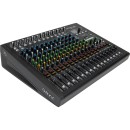
Mackie Onyx16 |
VS | ||
|---|---|---|---|
| 18 (8 Mono / 5 Stereo) | Number of Analog Input Channels | 16 | - |
| 12 | Number of Mic Preamps | 11 | - |
| 2x Stereo Master Output 2x Stereo Control Room/Monitor Output 2x Mono Aux Send Output 1x Mono FX Send Output 1x Stereo Headphone Output |
Analog Output Channels |
1x Stereo Master Output 1x Stereo Control Room/Monitor Output 1x Mono FX Send Output 1x Stereo Headphone Output |
- |
| 1x Stereo Main Mix per Mono Input Channel, Stereo Input Channel, Aux Bus/Subgroup | Mix Routing | - | - |
| 3-Band Semi-Parametric 3-Band Shelving/Notch/Peak |
EQ | - | - |
| Yes | Built-In Effects | 24x Preset (Factory) | - |
| 18 Tracks | Max Multitrack Recording | - | - |
| Yes | Rack Mountable | - | |
